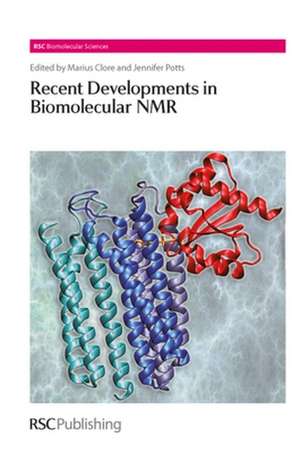Recent Developments in Biomolecular NMR: RSC Biomolecular Sciences (Numbered), cartea 25
en Limba Engleză Hardback – 31 iul 2012
NMR spectroscopy is widely used in biomolecular science particularly for structure determination of proteins, nucleic acids and carbohydrates. Much of the innovation within NMR spectroscopy has been within the field of protein NMR spectroscopy, an important technique in structural biology. Filling a gap in the literature, this book will draw together experts in the field to discuss the real advances in NMR methods that have occurred or have an impact on the biomolecular field in the last few years. The coverage will include recent developments in using NMR for determination of protein structures, membrane proteins, the dynamics of RNA and advances in NMR in drug discovery. Edited by leading biological NMR spectroscopists, the book will be an essential reference for researchers in industry and academia interested in or joining this bioanalytical field.
Preț: 1067.35 lei
Preț vechi: 1172.90 lei
-9% Nou
Puncte Express: 1601
Preț estimativ în valută:
204.23€ • 213.26$ • 168.65£
204.23€ • 213.26$ • 168.65£
Cartea se retipărește
Doresc să fiu notificat când acest titlu va fi disponibil:
Se trimite...
Preluare comenzi: 021 569.72.76
Specificații
ISBN-13: 9781849731201
ISBN-10: 1849731209
Pagini: 347
Ilustrații: Illustrations (some col.)
Dimensiuni: 162 x 241 x 28 mm
Greutate: 0.68 kg
Editura: Royal Society Of Chemistry
Seria RSC Biomolecular Sciences (Numbered)
ISBN-10: 1849731209
Pagini: 347
Ilustrații: Illustrations (some col.)
Dimensiuni: 162 x 241 x 28 mm
Greutate: 0.68 kg
Editura: Royal Society Of Chemistry
Seria RSC Biomolecular Sciences (Numbered)
Cuprins
Isotope-labelling of Methyl Groups for NMR Studies of Large Proteins; Low y-nuclei detection experiments for biomolecular NMR; Making the most of chemical shifts; Protein Structure Determination using sparse NMR data; NMR Studies of Disordered but Functional Proteins; Paramagnetic NMR Spectroscopy and Lowly Populated States; NMR Relaxation Dispersion Studies of Large Enzymes in Solution; Residual Dipolar Couplings as a Tool for the Study of Protein Conformation and Conformational Flexibility; Characterizing RNA Dynamics using NMR Residual Dipolar Couplings; Non-canonical ligand-binding events as detected by NMR; Advances in Biomolecular NMR for Drug Discovery; NMR of membrane proteins; Recent Developments in Biomolecular Solid-state NMR; Subject Index
Notă biografică
Dr Marius Clore's career began at University College London where he studied for his BSc in Biochemistry, moving to University College Hospital Medical School he became an MD and finally a PhD at the National Institute for Medical Research, London. In 1984, he became head of the Biological NMR Group at Max-Planck Institute for Biochemistry and then moved in 1988 to NIH, USA. He is currently an NIH Distinguished Investigator and Chief of the Protein Nuclear Magnetic Resonance Section and has made many pioneering contributions in the development of NMR spectroscopy for structural characterization of biological macromolecules. Dr Clore has been awarded numerous prizes and honours and was ranked in the top 20 in h-index ranking of living chemists in 2009. He is also a 3rd Degree black belt in Tae Kwon Do. Dr Jennifer Potts studied at the University of Sydney before becoming a postdoctoral fellow at the University of Oxford in 1992. Staying at Oxford until 2005 as a research associate and latterly lecturer in biochemistry, she then became Anniversary Reader at the University of York where her recent work has been on fibronectin recognition domains which fold on experiencing their target.
Textul de pe ultima copertă
NMR spectroscopy is a versatile and widely-used technique for studying the structure, dynamics or function of biomolecules including proteins, nucleic acids and carbohydrates. Much recent innovation within biomolecular NMR spectroscopy has expanded both the range of questions that can be asked and the biomolecular systems that can studied. Filling a gap in the literature, this book will draw together experts in the field to discuss recent advances in biomolecular NMR methods. The coverage will include developments in using NMR to study protein structures (including membrane proteins), disordered proteins, sparsely-populated states within molecular ensembles, the dynamics of RNA and advances in NMR in drug discovery. Edited by leading biomolecular NMR spectroscopists, the book will be an essential reference for researchers in industry and academia working in this field or interested in how this technique can enhance their studies of biomolecules.
Descriere
Filling a gap in the literature, this book will draw together experts in NMR spectroscopy to discuss the real advances in NMR methods that have occurred or had an impact on the biomolecular field in the last few years.

